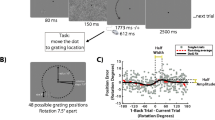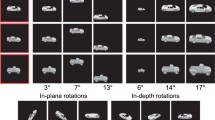Abstract
While it is often assumed that objects can be recognized irrespective of where they fall on the retina, little is known about the mechanisms underlying this ability. By exposing human subjects to an altered world where some objects systematically changed identity during the transient blindness that accompanies eye movements, we induced predictable object confusions across retinal positions, effectively 'breaking' position invariance. Thus, position invariance is not a rigid property of vision but is constantly adapting to the statistics of the environment.


Similar content being viewed by others
References
Foldiak, P. Neural Comput. 3, 194–200 (1991).
Wallis, G. & Rolls, E.T. Prog. Neurobiol. 51, 167–194 (1997).
Wiskott, L. & Sejnowski, T.J. Neural Comput. 14, 715–770 (2002).
Edelman, S. & Intrator, N. Cogn. Sci. 27, 73–109 (2003).
Ross, J., Morrone, M.C., Goldberg, M.E. & Burr, D.C. Trends Neurosci. 24, 113–121 (2001).
McConkie, G.W. & Currie, C.B. J. Exp. Psychol. Hum. Percept. Perform. 22, 563–581 (1996).
Watanabe, T., Nanez, J.E. & Sasaki, Y. Nature 413, 844–848 (2001).
Karni, A. & Sagi, D. Nature 365, 250–252 (1993).
Bedford, F. Trends Cogn. Sci. 3, 4–12 (1999).
Biederman, I. & Bar, M. Vision Res. 39, 2885–2899 (1999).
Dill, M. & Fahle, M. Percept. Psychophys. 60, 65–81 (1998).
Nazir, T.A. & O'Regan, J.K. Spat. Vis. 5, 81–100 (1990).
Dill, M. & Edelman, S. Perception 30, 707–724 (2001).
Wallis, G. & Bülthoff, H.H. Proc. Natl. Acad. Sci. USA 98, 4800–4804 (2001).
Simoncelli, E.P. & Olshausen, B.A. Annu. Rev. Neurosci. 24, 1193–1216 (2001).
Acknowledgements
We would like to thank B. Balas, N. Kanwisher and P. Sinha for their helpful comments on earlier versions of this work and J. Deutsch for technical support. This work was supported by the US National Eye Institute (NIH-R01-EY014970) and the Pew Charitable Trusts (PEW UCSF 2893sc). D.D.C. is supported by a National Defense Science and Engineering Graduate Fellowship. N.O. was supported by the Paul E. Gray Memorial Undergraduate fund.
Author information
Authors and Affiliations
Corresponding author
Ethics declarations
Competing interests
The authors declare no competing financial interests.
Supplementary information
Supplementary Fig. 1
Subjects tended to perform slightly better with object pairs that were never swapped on either side (“control” conditions) than with test object pairs across positions where those objects had behaved normally during the exposure phase (“unswapped” conditions), though this trend was not significant in either experiment. (PDF 49 kb)
Rights and permissions
About this article
Cite this article
Cox, D., Meier, P., Oertelt, N. et al. 'Breaking' position-invariant object recognition. Nat Neurosci 8, 1145–1147 (2005). https://doi.org/10.1038/nn1519
Received:
Accepted:
Published:
Issue Date:
DOI: https://doi.org/10.1038/nn1519
- Springer Nature America, Inc.
This article is cited by
-
Recognizing why vision is inferential
Synthese (2022)
-
Convolutional neural networks explain tuning properties of anterior, but not middle, face-processing areas in macaque inferotemporal cortex
Communications Biology (2020)
-
Object responses are highly malleable, rather than invariant, with changes in object appearance
Scientific Reports (2020)
-
Object discrepancy modulates feature prediction across eye movements
Psychological Research (2020)
-
Perceptual straightening of natural videos
Nature Neuroscience (2019)





